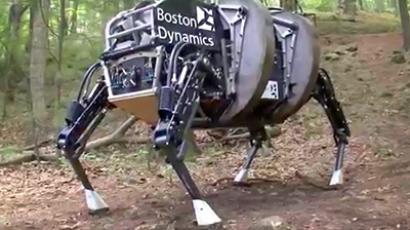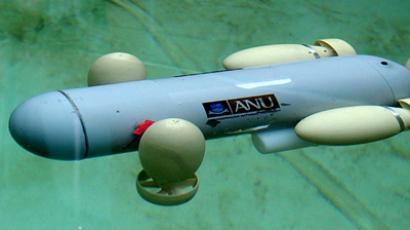Pentagon’s DARPA preparing to equip robots with ‘real’ brains

Is the Pentagon trying to freaks us all out, or do they just want to give zombies something to eat? The Department of Defense is reportedly almost finished building robots with “real” brains.
That’s according to National Defense Magazine, which this week profiled the Pentagon’s Defense Advanced Research Projects Agency (DARPA) lab and a little known project that has sucked down millions of dollars during the last few years: millions of dollars spent trying to replicate the human brain.
National Defense Magazine’s Sandra Erwin explores the “physical intelligence” program this week, a research and development initiative launched back in 2009 in order to “to understand intelligence as a physical phenomenon and to make the first demonstration of the principle in electronic and chemical systems,” according to the Defense Department’s original solicitation.
Erwin says that four years later, a team of scientists led by University of California, Los Angeles Chemistry Professor James K. Gimzewski is just “inches away from the finish line” in terms of reaching their goal.
Gimzewski and crew have constructed a tiny machine, Erwin writes, that allows robots to attack independently. How independently? It won’t rely on convention computer code used to program cyborgs and robots like the kind found in Hollywood sci-fi flicks, but instead use microscopic wires to emulate the electrical and chemical pulses sent from cell to cell within the human brain.
“Rather than move information from memory to processor, like conventional computers, this device processes information in a totally new way,” says the scientist
Erwin continues:
“What sets this new device apart from any others is that it has nano-scale interconnected wires that perform billions of connections like a human brain, and is capable of remembering information, Gimzewski said. Each connection is a synthetic synapse. A synapse is what allows a neuron to pass an electric or chemical signal to another cell. Because its structure is so complex, most artificial intelligence projects so far have been unable to replicate it.”
According to DARPA, “The objective of the implementation domain is to demonstrate the first human-engineered open thermodynamic systems that spontaneously evolve nontrivial ‘intelligent’ behavior under thermodynamic pressure from their environment.”
“The objective of the analysis domain is to develop analytical tools to support the development of human-engineered physically intelligent systems and to understand physical intelligence in the natural world,” the agency writes.
On the website for UCLA’s Mechanical and Aerospace Engineering department, the goal of the “physical intelligence program” is described a bit more succinctly. “The project will not only lead to fundamental understanding about various physical and biological self-organization systems and origin of intelligence, but also practical applications such as the creation of next generation of electronic circuits with intelligent behaviors, and dynamic interactions/control of biological systems,” says UCLA’s Yong Chen.
Dr. Gimzewski tells National Defense Magazine that a team of scientists have made great strides in the multi-million dollar project, even if it’s the most ambitious one he’s seen yet. But what happens when it’s finally complete?
“It is not clear, however, that the Pentagon is ready to adopt this technology for weapon systems,” writes Erwin, citing a Defense Department policy statement from last year that limits the Pentagon’s power to make autonomous robots.
Meanwhile, though, other DARPA operations like the PETMAN project reported by RT earlier this week suggest it’s only a matter of time before the military has some form or another of weaponized robot warriors.














